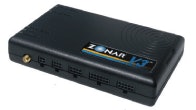Making the latest technology developments work for your fleet
Full circle
TMW Systems acquired, primed for growth
By Aaron Huff
TransForum 2012, the annual user conference of TMW Systems and the trucking industry’s largest technology gathering, was different than its past six years on one account – the size of the audience. The Orlando Peabody convention center ballroom was filled with 1,500 people during the keynote address by David Wangler, chief executive officer.
 David Wangler, chief executive officer of TMW Systems, spoke to 1,500 people during his keynote address at TransForum 2012.
David Wangler, chief executive officer of TMW Systems, spoke to 1,500 people during his keynote address at TransForum 2012.Perhaps more noteworthy was the fact that Wangler announced TMW was part of a global publicly traded company, Trimble Navigation. In August, Trimble purchased TMW for $335 million, which one can assume is many times the amount that two private equity firms quietly paid TMW founder Tom Weisz in 2005 to acquire the company.
Since then, TMW has had the capital to make large acquisitions. The first was rival Maddocks Systems in 2006. After adding Maddocks’ TruckMate to its TMWSuite line of enterprise resource planning systems, TMW acquired complementary products in TMT Software (fleet maintenance management) and IDSC (business intelligence and asset optimization) in 2007. TMW bought another rival, Innovative Computing Corp., in 2009.
In 2011, it acquired Appian Logistics and gained a foothold in route planning and optimization scheduling. These acquisitions – added with TMW’s organically grown products – have put the company in a position to serve “an entire spectrum of surface transportation business needs,” Wangler said. TMW now provides end-to-end software systems with focused complementary products to more than 2,300 different transportation companies.
*‘An entire spectrum’: Acquisitions and TMW’s own products have created a large market.
*Economies of scale: The company can use its resources to improve processes and best practices.
*New products, big backing: TMW’s management team plans to keep the momentum going.
As everyone knows, acquisitions remain complex transactions long after the ink is dry. For its part, TMW has to sell and support multiple ERP software platforms with overlapping features. On the other hand, the company has been able to scale its resources to improve processes and best practices in development, implementation and support.
“In a large organization, where more people are doing the same things, they are likely to get better at it,” Wangler told CCJ. One example is the company’s Vancouver office – the former Maddocks headquarters – developing a new less-than-truckload module for TMWSuite.
Another byproduct of scale is deeper relationships and integration opportunities with other technology suppliers to the trucking industry that share mutual customers across TMW’s platforms.
The company announced two new products that it says are the first phase in a new wave of integrated functionality to serve the complex needs of diversified transportation providers, with or without fleet assets. The products leverage sophisticated algorithms based on the core Appian product, DirectRoute, to consider consolidation and mode shift opportunities, lowest-cost carrier and carrier performance levels.
 Aaron Huff is Senior Editor of Commercial Carrier Journal. E-mail [email protected] or call (801) 754-4296.
Aaron Huff is Senior Editor of Commercial Carrier Journal. E-mail [email protected] or call (801) 754-4296.TMW Transportation Modeler is designed for bid proposal and strategic network planning. TMW Mode Planner is used to plan customers’ shipments into optimized loads automatically in order to produce lowest-cost transportation options to be executed using TMWSuite.
With these and other new products hitting the shelves and with Trimble’s backing, TMW plans to keep the momentum going. “We will run the business more or less autonomously,” Wangler said. “If we liked what we were doing before, we will continue to do that.”
Zonar debuts V3 telematics platform
Zonar, a provider of electronic fleet inspection, tracking and operations systems, introduced its next-generation V3 telematics platform designed to collect data directly from the vehicle’s electronic control module, integrate that information with satellite GPS readings and transmit the data over 3G networks for immediate, precise reporting.
 Zonar’s V3 telematics platform is designed with GPS tracking, 3G high-speed data connection, a built-in accelerometer, Wi-Fi and power sleep mode.
Zonar’s V3 telematics platform is designed with GPS tracking, 3G high-speed data connection, a built-in accelerometer, Wi-Fi and power sleep mode.“The V3 takes our comprehensive vehicle tracking and diagnostics solutions to a whole new level,” said Mike McQuade, chief technology officer at Zonar.
A three-axis accelerometer is designed to sense changes in gravitational force, including front-to-back, side-to-side and up-and-down to accurately determine motion and orientation to determine hard braking, hard acceleration and hard cornering.
The V3 also features real-time vehicle diagnostics to help improve vehicle uptime and maintenance operations; fault code data is delivered instantly to fleet managers and dispatchers, and fleets can schedule shop time and maintenance resources in advance to reduce vehicle downtime.
In Focus: Low-cost EOBRs
A new point of entry
Looming EOBR rule prompts vendors to offer new mobile technology
by Aaron Huff
Inspection officers permit drivers to use any number of electronic devices to record logbook information. Today, if an officer questions the accuracy of the device, the driver always can revert back to paper logs. Not too long in the future, however, drivers not using certified electronic onboard recorders will be placed out of service.
The Federal Motor Carrier Safety Administration is expected to issue a proposed rule in March 2013 to mandate EOBR use by an estimated 3.4 million drivers. The agency then likely will issue a final rule in October 2013 to comply with the Moving Ahead for Progress in the 21st Century (MAP-21) highway bill signed into law last July. The October 2013 deadline is to allow time for public comment and review by the White House for the rule to become law in January 2014.
Technology companies vigorously are creating new products targeting the large number of small fleets and independent contractors that will be looking for a simple low-cost EOBR system to comply with the law.
The Android option
Qualcomm Enterprise Services soon will release an Android platform that will run the same hours-of-service, messaging, workflow, safety and performance monitoring applications as the company’s present MCP; the difference is that consumer-style Android devices can be used for the display unit. Applications on the devices will sync with a stationary “black box” in the vehicle.
Small fleets and owner-operators will want a simple low-cost system.
The Android platform likely will be used by fleets of 25 trucks or less, says Norm Ellis, QES vice president of sales and marketing. Larger fleets will continue to prefer more durable vehicle-mounted displays to run their enterprise applications, Ellis says.
Rand McNally recently announced an HD 100 platform compatible with Android tablets and the company’s IntelliRoute TND 720 truck GPS device. Rand McNally plans to make the new platform available in April 2013.
The HD 100’s HOS recorder plugs into a truck’s onboard diagnostics port and records the truck’s GPS position along with vehicle-specific information such as engine diagnostics and driving behavior. The recorder syncs with mobile devices in the vehicle through Wi-Fi and has a CDMA wireless modem that connects to a Web-based fleet management system.
J.J. Keller & Associates offers a standalone system for EOBR and electronic driver vehicle inspection reports. The recorder costs $199 and is compatible with most Android smartphones, tablets and laptops. Fleets get the Encompass E-Logs online reporting service for $3 per month with upgrade options to capture a range of driver performance metrics.
PeopleNet does not plan to offer an EOBR system compatible with consumer devices. Its current Blu and Tablet platforms are designed for enterprise applications such as messaging, driver safety, compliance and performance management. The company offers a no-money-down EOBR bundle for $48 per month that includes an onboard computer, LCD display and eDriver Logs application.
Beyond compliance
In addition to offering a low-cost EOBR application, some technology companies include a full fleet management platform that runs on the latest consumer devices, tablets and wireless networks.
XRS, formerly known as Xata, will release a new version of its mobile fleet management system in March 2013. The new XRS system will be compatible with dozens of Android smartphones and tablets with no upfront hardware costs or long-term contracts.
To implement XRS, a fleet or driver simply plugs a small relay device into the vehicle’s diagnostics port and downloads the XRS mobile app to a smartphone or tablet. The mobile app includes training and self-help tools so that drivers and vehicles can stay on the road as fleets bring new HOS and other applications online.
TeleTrac’s introductory EOBR package includes a 5-inch tablet with the same features as the company’s larger 7-inch tablet. The package is offered with monthly pricing and no upfront hardware costs. Besides HOS compliance, the package includes navigation and messaging.
Zonar’s new 2020 tablet for its fleet management system will be compatible with the company’s future EOBR systems. The 7-inch display screen can be customized with purchased or proprietary apps such as navigation, pre- and post-trip inspections, HOS and real-time driver coaching. The 2020 retails for about $500 and includes a SD/MMC card slot, 5-megapixel camera with LED flash, video recording capability, in-cab training, Bluetooth and built-in flashlight.
While looming regulations will mandate the use of EOBR technology, they also have opened up new low-cost opportunities for fleets to deploy high-tech fleet management systems.
J.J. Keller rolls out pre-employment screening service
J.J. Keller & Associates announced it now offers a pre-employment screening program service to provide carriers with a complete review of a driver’s history and aid in the hiring process. Carrier customers will receive a PSP scorecard with an overall evaluation based on variables tied to driver performance.
“Today, carriers have to sift through complex PSP reports from the Federal Motor Carrier Safety Administration,” said Scot Rambo, J.J. Keller’s director of compliance services. “We interpret these driver history reports to provide a clear assessment, as well as explain the meaning behind the data presented in the PSP.”
J.J. Keller said the PSP Analysis uses weighted scoring based on violation severity and elapsed time, as well as crash history. Scores are summarized by Compliance Safety Accountability BASIC, providing carriers with an overall assessment. Information is based on three years of roadside inspection data and five years of crash data.
J.J. Keller said that in addition to aiding in hiring decisions, the assessments help manage fleet CSA scores, can be used in driver training and improve overall hiring processes.
The PSP Analysis Service is a complement to J.J. Keller’s Driver Qualification Service, which tracks all FMCSA-required documentation for CMV drivers. For more information, go to www.jjkellerservices.com/psp.











